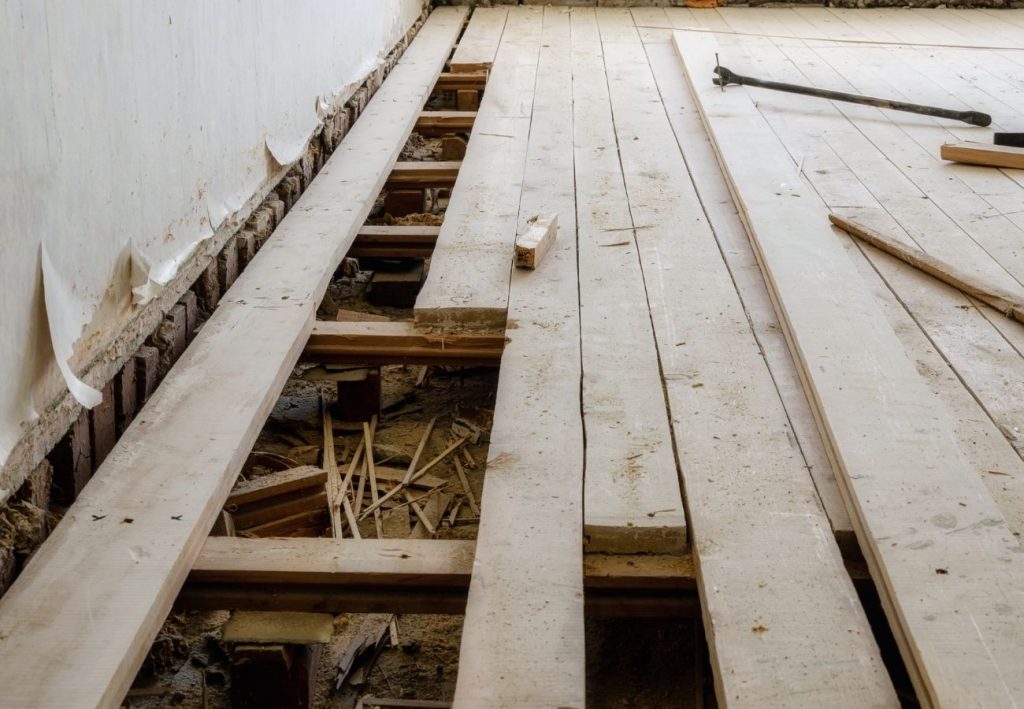
Uneven Floors – What Are the Causes and What Can You Do?
If your house has uneven floors, you may have also noticed other problems, such as sagging floors or jamming doors. These are only two signals that your house might have some serious foundation problems. An uneven or sagging floor is usually caused by poor structural design and the foundation of the floor underneath. Flooring issues are typically not caused by the floor problems themselves. The cause is usually a shift in the foundation underneath the floors and a crawl space structural issue. However, a sagging crawl space, uneven floors, and floor cracks in an old house are worrying but can be fixed.
How to Measure Floor Slopes?
Are you wondering whether you are overly sensitive or just imagining that your floors are uneven or sloping? If this is your case, then you should know how to measure the slopes on the floor. Here are some ways of how you can do this:
Golf Ball
One of the easiest ways to confirm whether your floors are uneven or sloping is to use a golf ball. You could also use other round objects such as a steel bearing or marble.
To use this, put it down on the floor. If it rolls away, then it’s a sign that the floors are not even. If it rolls fast, then that means that the slope of the floor is high. This is a common technique used by many home inspectors.
Levels
Another way of identifying whether your floors are sloping is by using levels. There are torpedo levels that are 3 feet long, and these can help you determine whether there is indeed a slope on the floor. However, using a laser level is much easier and more convenient.
Let’s have a quick look at the video below that shows how you can easily level a sloping floor using a laser level:
If you don’t have a laser level, you can download phone-level apps. There are many free and paid versions of these, and they can work equally and with other levels.
What to do if you find out that there is a slope on your flooring? Well, insurance companies, engineers, and builders have different opinions. But slopes to a certain degree are acceptable. However, to be sure, call a professional to provide you with your best options.
What Are the Causes of Sloping and Uneven Floors?
Uneven floors have slopes or dips, making the concrete floors uneven. However, this is not usually because of a bad flooring job. Here are the possible causes of sloping or uneven floors:
Soil Movement
Soil movement is quite natural. When it’s wet, it will expand. Meanwhile, when it’s dry, it will shrink. Since your home is situated in a soil foundation, it’s bound to be affected by the movement hence causing slops and sagging on your flooring.
As builders lay the foundation of a building or house, they compact the soil underneath it. However, sometimes, the soil is not compacted enough so that even a concrete floor can lift or sink, and the interior wall cracks.
Extra Moisture
The most common cause of uneven floors is water damage or excess moisture. Water from pipes underground or hidden behind the walls can leak, then eventually cause the sub-flooring to warp.
Moisture can also cause damage to the building’s foundation and concrete floors, especially if it’s caused by poor drainage. This is mostly the case in homes situated in locations that have multiple seasons.
A crawl space structural issue can also cause squeaky floors. The floor beams of a typical crawl space are made from wood and will most likely bend after a while.
Foundation Damage
Another common cause of uneven or sloping floors is foundation damage. The damage can be caused by poor construction or aging. If this is the cause of your uneven flooring, it is important to have it fixed immediately. Structural damage can cause wall cracks and sagging floors. In extreme cases, it can lead to the collapse of a building.
What Can You Do About Sloping and Uneven Floors?
According to the Consumer Product Safety Commission, uneven floors and flooring materials contribute to over 2 million fall injuries every year. Suppose you don’t find a solution to this problem. In that case, you are making yourself susceptible to many risks, such as further property damage and injuries.
With that in mind, here are a few things that you can do if you have sloping and uneven floors, depending on their causes:
Uneven Floor Due to Soil Movement
Sagging floors due to soil movement is fixable. But, to do that, you will need the help of a building or flooring professional who will diagnose the extent of the damage. Once your building is already assessed, the professionals will then provide you with options for fixing the problem.
These options can include adding a slanting swale or fixing your foundation grading. A slanting swale acts as a barrier to prevent water from entering your foundation. Meanwhile, a foundation grading should have around a 3% or 5% slope around the house.
Uneven Floor Due to Extra Moisture
Suppose the reason why your floors are sloping and uneven is because of moisture or water damage. In that case, you don’t have to worry because it’s fixable.
The first thing that you have to do is address the moisture and water problem. This is easy once you have identified the source of the leak.
When fixing this, you will need a professional plumber. It’s better to have them fix it for you because a home’s plumbing system can be complex, and if you don’t have any plumbing know-how, you might cause more damage.
Once the leak is fixed, you need to start with the foundation repair, if there are any. This can be trickier and more expensive, depending on the extent of the damage. However, it’s best to leave it to the professionals to ensure that the job is done properly.
Uneven Floor Due to Foundation Damage
Among all other reasons why your flooring is uneven or sloping, foundation damage is the most difficult and expensive to fix.
Some of the ways that experts fix foundation problems are by installing floor jacks and foundation piecing. To do this, professionals will need to pump grout strategically into holes beneath your foundation to raise it back to its original position.
Sounds complicated, right? Well, it is, but it’s necessary for the safety of those occupying the building and to avoid further damage to the other parts of the building.
Final Words
Sloping and uneven floors are not good signs. They usually mean that the building has underlying problems and needs foundation repair. However, just like other things, early detection is key, so make sure to be vigilant of your surroundings to avoid more issues such as greater damage and physical injuries.
